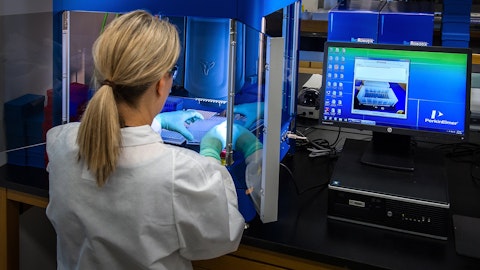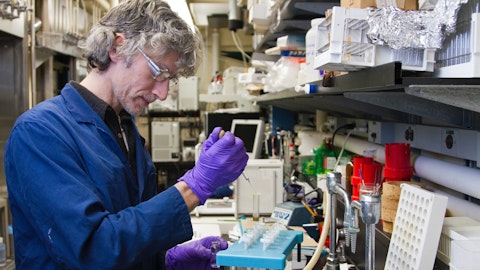Bradley Campbell: Yeah, that’s something we did with Galafold, Ritu, you might remember. And so I think that is a key leading metric in the U.S. where you go through that PRF process. So I do think we’ll provide, we’ll likely provide color on that in a rear. So looking backwards, we did it for, an initial period, and then we focused more on patients. Once you get into kind of the rhythm, it’s really patients on drug, that’s more important. So stay tuned for that.
Operator: Thank you. Our next question comes from the line of Joseph Schwartz of Leerink Partners.
Joseph Schwartz: Thanks very much, and congrats on all the progress. Based on the figures you provided, it looks like you’ve already seen around 33 PRFs since launch in the United States. I was wondering if you could give us any insight into how many of those are de novo versus expanded access patients? And are you still anticipating being able to convert all expanded access patients to commercial therapy by the end of the year? I think there were around 50 total. And how long do you think it might take to move patients from a PRF to commercial therapy? And then in the U.S., are you seeing any demand outside of the EAP that you can quantify for us? And how much lumpiness do you think there might be once you work through the initial EAP bolus, if you will? Thank you.
Bradley Campbell: Yeah. Thanks, Joe. All good questions. So, Mike, maybe talk a little bit about the sort of initial time from PRF to infusion, and then kind of what we see it from a Galafold perspective, kind of more the steady state process. And then talk a little bit about, provide a little bit more color on the distribution of clinical trial conversions versus new patients, new switch patients. I think that covers most of what you asked, Joe.
Mike Kaveney: Sure. When we look back on Galafold PRF to shipment times at launch, it was about 60 to 90 days because it’s a new product. Payers need to sort of go through their process, get it on formulary. So, in general, it’s about 60 to 90 days. We do, and we have here, we do get authorization sometimes more quickly than that. But on average, we’re looking at the 60 to 90 day window for any really new rare disease product to get through the payer system. Over time with Galafold, we’re a little over five years out now with Galafold. It’s down below 30 days, and we would expect that trend to continue with probability and unfold over time. And so, we don’t really have a specific number yet on PRF to shipment time because we’re just starting out but we’re anticipating, the 60 to 90 day window with some coming before.
We already have more than a handful of approvals from payers, and we just got some of those PRFs in the mid-October timeframe. So, we’ve already seen that go well in a couple of cases. But again, it will take payers a little bit of time to go through the product. The second question was…
Bradley Campbell: The mix of clinical trial conversions and then new patients.
Mike Kaveney: Sure. The vast majority right now have been clinical trial. We’ve got a handful, a little bit more than a handful of patients who weren’t in the clinical trial that we received PRFs for. And as I said, some of those are switches from Lumazine. Some of those are switches from Mexviazine.
Bradley Campbell: Yeah. So, I think, Joe, as I maybe I mentioned in answer to another question, the vast majority of patients this year will be conversion patients in each of the markets, but we’re really thrilled that in the UK and in Germany and the US, we’ve already seen multiple new commercial prescriptions come in who are not conversions. And so, I think this year, if you kind of project out to the end of the year, the majority will come from conversions, but our goal is to maximize the number of new commercial starts as well over the course of this year. And then keeping in mind the timeframe that Mike suggested and looking at the stats in other markets, our goal also is to convert all of the patients this year. And so, next year, the vast, vast majority of demand is going to come from new commercial patients.
Operator: Thank you. Our next question comes from the line of Ellie Merle of UBS.
Sarah Kwok: Hi, this is Sarah. And for Ellie, thanks so much for taking our question. A few quick ones from us. I guess, can you give us a sense from speaking with physicians, any feedback that you’re hearing, either on the number or the% of their patients that are declining or not improving on standard of care, and also how physicians are deciding between your product and Nixviazyme in terms of switching a patient to a new therapy? And then earlier, when you mentioned that 50-50 split between Myozyme and Nixviazyme, is that something that you think continues to play out longer term? Or how do you see that looking? Thanks.
Bradley Campbell: So maybe I’ll take the second two questions. And then, Jeff, maybe you can talk to the first one in terms of how physicians are evaluating a patient’s response to therapy. So, over time, I think it depends on which market you’re talking about, right? So in the United States, it’s I think north of 50% of patients now have been reported to have come on to Nixviazyme. And so our anticipation is that you’ll draw probably relatively equally from both of those segments. Because they’re, roughly equally weighted, maybe maybe a handful more Nixviazyme patients. In other markets, you have a smaller penetration of Nixviazyme. So still, the majority of patients are on Myozyme. And I think there you’ll see kind of relatively equally weighted distribution.
And, and so I think, it’ll be kind of a market by market conversion rate. The most important thing is that the label, and we talked about this, and this is why it’s so important, some of these key elements of label, that is agnostic to end to replacement therapy. So it doesn’t matter whether the patient’s on Myozyme or Nixviazyme, the physician and the patient are going to focus on the, on the data. And, and we would remind people that we’re the only product that has in a well controlled study, looked at patients switching from an active comparator to our product. And we’ve shown improvement of six minute walk and stability and force vital capacity. So that’s really the differentiate data set that we have that we are using to go talk with physicians around options for therapy.
So Jeff, do you want to talk a little bit about kind of improvement and, and why that’s so important and why it captures such a broad opportunity for us to differentiate?
Jeff Castelli: Sure, Brad, and thanks for the question, Sarah. So, we have done some market research and conversations, with physicians and based on what they’re telling us, it’s 75% approximately of their patients are not improving. And that means they’re either worsening or stable. And based on the data we have, and, the data that suggests there is a possibility for actually improvement in both naive and switch patients, that really seems to be the main driver of a decision, a big one we’ve also seen, and remember this is early days, majority of the current commercial switches are from our trial access patients. So it’s a small end, but, it’s really that potential for improvement in sort of the experience that either physicians or patients have had.
And, we think that those anecdotal reports of how patients are doing as that spreads throughout both the physician and patient community is going to be a big driver as well, but still early days. And we’ll continue to listen to hear the specific reasons different patients are deciding to switch or physicians are deciding to have their patients switch, but we think it’s going to be driven by efficacy and patient experience.



